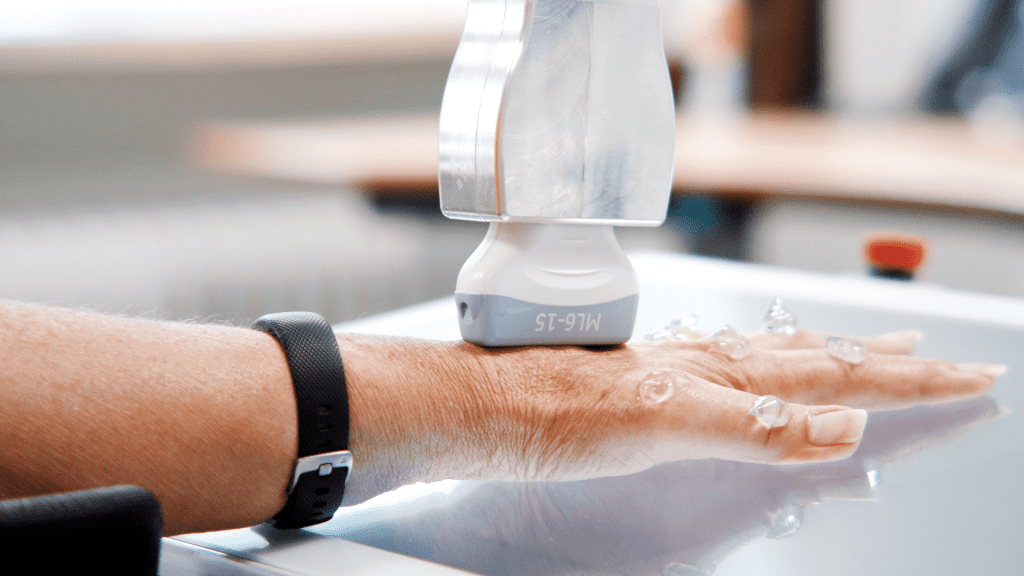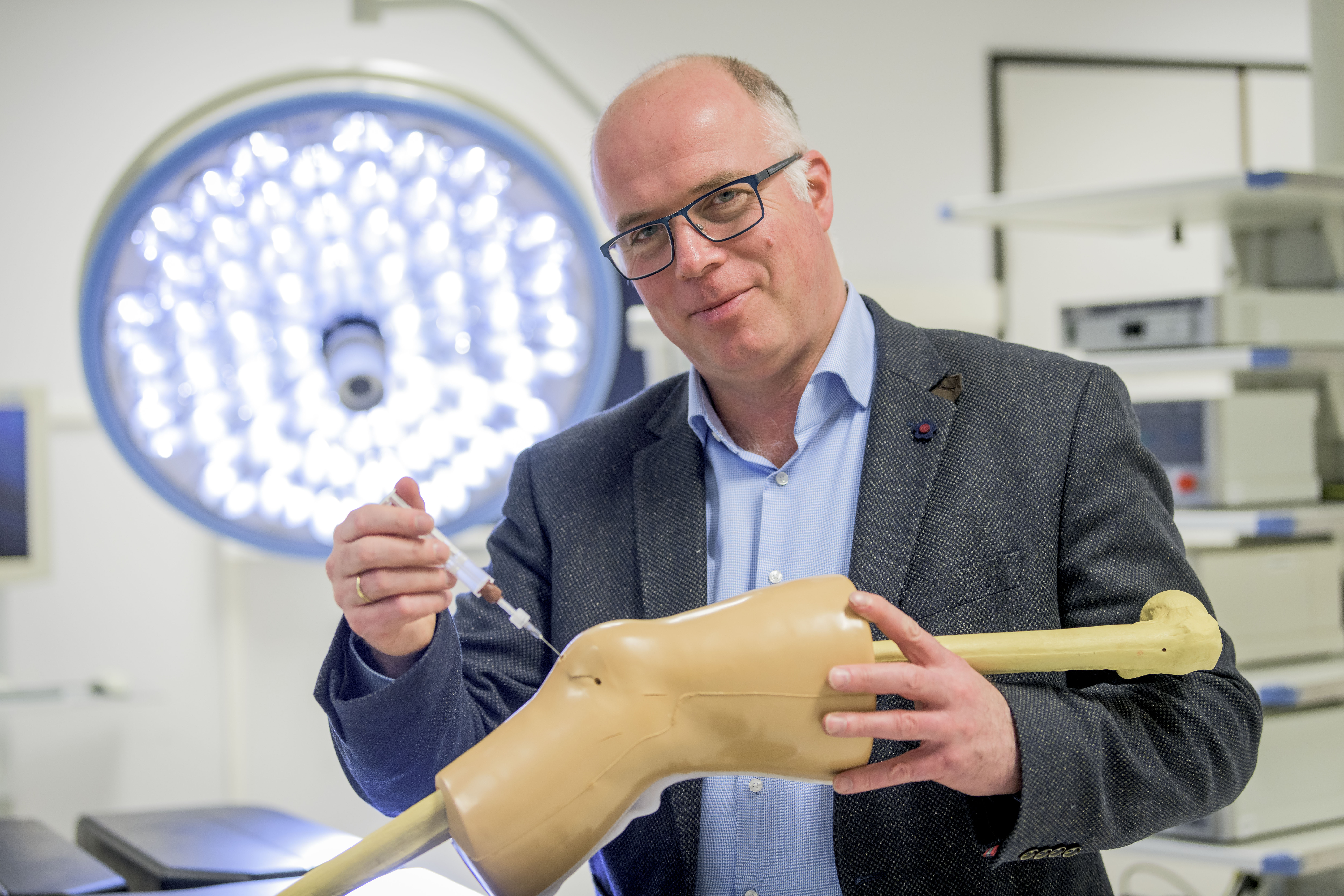
Pain, swelling, and stiffness in the joints are all symptoms associated with Rheumatoid Arthritis – RA. It is a chronic disease that causes inflammation, especially in smaller joints. Early detection prevents permanent joint damage, discomfort, as well as the loss of accessibility to the labor market. RA occurs at all ages, usually starting in the 25 to 45 years old age group. Due to a severe shortage of rheumatologists – RA specialists – it can take months to get an appointment, leaving patients in discomfort and at risk of permanent damage to their joints. An automated robot is lending a hand to address this problem.
RoPCA – a spin-off company from the University of South Denmark (SDU) and Odense University Hospital (OUH) in Denmark – has developed ARTHUR, the first fully automated robot for scanning arthritis. It performs an ultrasound test in 15 minutes, and by providing audio and written instructions, guides the patient during the process.
‘Doing something together’
The word ARTHUR is a combination of the words Arthritis, Ultrasound, and Robot. It is the result of three years of research and development. RoPCA – which stands for Robotic Platform for Clinical Automation – was founded in 2019, after receiving a grant from Energi Fyn – a Danish energy company. Then five private investors also joined the venture.
“It all started when I met professor Thiusius Rajeeth Savarimuthu, the other co-founder, who teaches robotics at SDU. Our kids went to the same school, so we got to know each other that way,” recalls Dr. Søren Andreas Just, cofounder of RoPCA and clinical researcher at OUH. “I was looking at arthritis all day, he was making robots, so we thought of doing something together.”
Rising figures
According to recent research, RA affects about 0.24 to 1 percent of the population, where women are twice as much at risk. A World Health Organization (WHO) document from 2019 says there will be 2.1 billion people aged 60 and older by 2050, up from just under 1 billion in 2017. Consequently, the number of people with RA is also set to increase. ARTHUR can help now, since it has received CE certification – Conformitè Europeenne, or European Conformity – and is now ready to be used in hospitals.
“It’s the first robot in the world to do so,” stresses Just. “The waiting lists are too long so that patients are left suffering in pain for months. So, we thought about whether arthroscopy and grading disease activity in RA could be automated.”

Søren Andreas Just
RoPCA’s co-founder
He works as a clinical researcher at Odense University Hospital, Denmark.
Robot detects arthritis in 15 minutes
Sitting on a chair next to the robot, the user places a hand on the device’s touchscreen. A barcode reader identifies the patient by their health insurance card. All the while, the robot keeps providing information both through the screen and its voice – even including how to use the gel on the hand. Using its camera, ARTHUR takes an initial scan to identify the hand and where the joints are. After that, the ultrasound scan starts. The robotic arm examines 11 joints on each hand, one at a time. Once the scan is completed, ARTHUR analyzes each image for signs of arthritis and measures its prevalence, then sends a report to the doctor and stores it in the patient’s electronic health file.
“During the process, algorithms in ARTHUR check whether the scans have the quality they need to have. The robot is able to recognize if certain features are not adequately depicted on the ultrasound image of the joint. In that case, the robot asks the patient to take another scan of that joint,” explains Johannes Schaeferhoff, CEO of RoPCA.
Patients felt no difference when scanned by the robot compared to a scan performed by a rheumatologist. The Danish company experimented with a group of people that were first scanned by the robot and then repeated the same test with a specialist. The data collected suggested no significant variations in discomfort or pain levels between the two tests. Over 9 out of 10 patients said they wanted to keep ARTHUR so that they could monitor the disease. In RoPCA’s vision, the robot could also help specialists check on patients remotely. This could be of particular help in remote areas.
Fully AI-driven diagnosis
Along with the robot, the Danish firm has also developed DIANA. This software is integrated into ARTHUR, but it can also work as a stand-alone product. It is the acronym for DIagnosis Aid Network for Rheumatoid Arthritis, and works as a supplementary tool to monitor and detect RA. It analyzes ultrasound images for early RA detection and quantification of disease activity by means of machine learning technology. The system complies with international standards for the recognition of disease activity.
When working without the robot, DIANA can still check the scans that rheumatologists take manually. Even without ARTHUR, specialists can have a ready-to-use tool that can help them.


Automating ultrasound scanning
As the company is getting closer to being launched on the market, large-scale trials will take place to gain more evidence on how ARTHUR functions. According to Just, this could help in tackling diseases other than RA.
“RA is the starting point. Given the lack of personnel in a lot of specialisms who can perform a scan, there are many more areas for the automation of healthcare systems. The good thing is that these scans are standardized – both in the way they are performed and in the interpretation of the results. This eases the way for the adoption of tools such as AI and machine learning to assist doctors and patients,” Just adds.
RoPCA won the 2022 Kuka innovation award. As a leader in robot-based automation, the German firm hands out prizes each year to accelerate innovation in this field. ARTHUR participated in this edition of the “Robotics in Healthcare Challenge” and won the first prize valued at €20,000.

